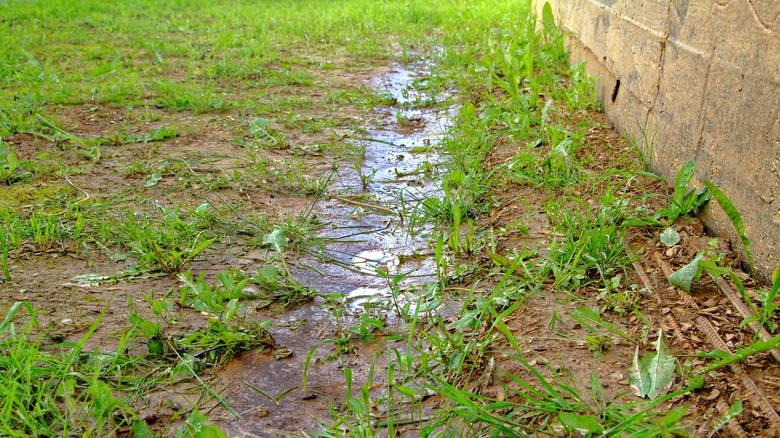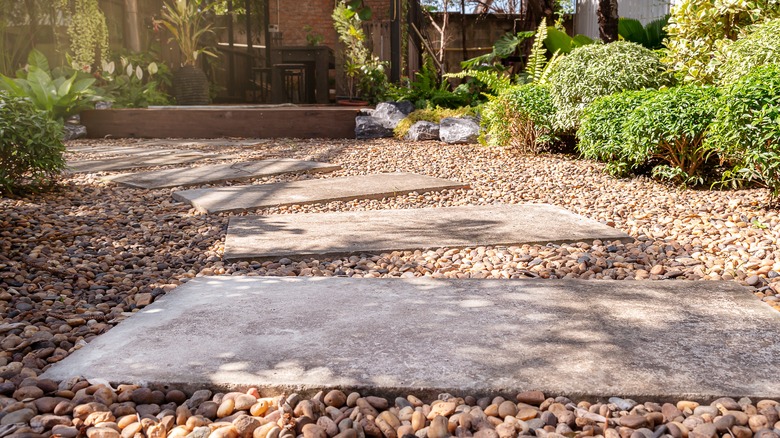The Paver DIY That'll Instantly Improve A Muddy Path Between Neighboring Houses
Are rainy days leaving you with a boggy mess of lawn? A muddy backyard is few people's idea of fun — aside, maybe, from mud pie-making toddlers. If you want to grow a garden, enjoy that grill gazebo that sets your backyard apart from the rest, or make sure your — and your neighbor's — basement or foundations are protected from water infiltration, you need to do something about all that water. Instead of paving the entire area, use pavers as stepping stones only and fill the remaining area you would typically pave with gravel. It looks great, you can still walk on it, and it's less work to install. Plus, if you love backyard birds, gravel is known to attract killdeer birds to your yard!
But perhaps the best part of using gravel is that it acts as a natural drainage solution. The gaps between the stones help to evenly and slowly distribute water into the soil below, avoiding the overwhelm that causes mud and puddles. The material acts as a sort of soakaway-style drainage system; think of the path you're creating as an extended splash strip. There's no need to lay additional drainage in most cases, saving you money and time. On the flip side, if the patio or pathway was constructed entirely from pavers, you would need drainage, since that surface is impermeable — the water runs off the surface, needing somewhere to go, instead of soaking in like it does with gravel.
Types of gravel for the perfect path
What's most important is what kind of and how much gravel you need to reduce bogginess. Measure the area and use an online calculator to determine gravel volume, like Burien Sand & Gravel's cubic yards calculator or the gravel calculator on Calculator.net. Expect to pay anywhere between $3 and $7 for each square foot of area you want to path with gravel. If you have significant areas of standing water, consider asking a drainage professional to assess your yard for drainage. You don't want to invest in DIYing the path only to learn you're the rare case that needs drains.
You'll need two kinds of gravel. First up is a bottom drainage layer of stone 1/2 to 1 inch in size — #57 stone is an expert-recommended choice, which Bulks Landscape Supply sells for $81.70 a ton. Top that layer with your favorite decorative gravel. Stones under 3/8 of an inch are the most comfortable to walk on. Manufactured crushed rock works great for areas that see a lot of use, whereas smooth, fine stones are most comfortable underfoot but can be harder to contain. Pea gravel is popular because it's aesthetically pleasing, widely available, and affordable: Home Depot sells half-cubic-foot bags for $4.58 each. Fancier (and pricier) options include glass gravel, river rock, and slate chips. For example, get 100% recycled mixed-color landscape glass rocks (1/2 to 1 inch in size) for $102.50 per 50 cubic feet from Bluestone Supply.
Create your mud-banishing patio
Choose pavers that comfortably fit 2 feet. Any material works, from pre-cast concrete pavers to old-world flagstones. Prefer that cottage-core vibe? Mismatched garden pavers are no problem at all! Use leftovers from a friend or neighbor's recent renovation project or sourced on secondhand sites like Facebook Marketplace. Avoid landscape fabric or weed mat. It will eventually peep through the gravel. Put some thought into edging the pathway — if it's overhung by plants, you can get away with basic bricks, but if it visibly abuts your lawn, you might want something nicer like metal, natural stone, or wooden sleepers.
Gather the tools you need for the job, including a wheelbarrow to haul and dump the gravel, a 6 or 8-inch-square hand tamper, a shovel, a tarpaulin, and lawn chalk or non-toxic spray paint, and a rake. First, mark out your pathway (or pathways) with the paint or chalk. Remove the top layer of grass or soil inside the lines to about 3 or 4 inches deep, placing it on the tarpaulin for easy clean up. Compact the soil in the trench using the hand tamper or roller. Put down the base gravel layer, water it using your garden hose or a watering can and compact it with the tamper. Place your pavers on top of this layer with a thin layer of builders sand underneath them and install your edging of choice. Add the decorative gravel layer, using your rake to level the surface.

